When our son Kevin was little he loved sand dunes. For him the dunes were like a giant sandbox – and what kid wouldn’t love that?
I also like to play in the dunes. I don’t usually dig in the sand (though maybe I should), but as a photographer the dunes seem like a giant visual playground. There are lines and curves and patterns and textures everywhere you look. Entering the dunes I feel like a kid walking into a candy store with a crisp twenty-dollar bill that grandma just gave me for my birthday.
Last week Claudia and I camped for a few days in Death Valley with our friend Robert Eckhardt. I made several trips out to the Mesquite Flat Dunes, which was pure fun. At times it seemed like there were compositions everywhere I looked. The only problem was that there was never enough time to capture all the compositions I saw while the light was good.
I’m always looking for patterns, and especially so in the dunes. Looking for patterns means finding repetition – lines or shapes that echo each other. It’s about creating rhythm and harmony within the frame (as I wrote about here). Repeating patterns are an essential element of nearly every successful photograph.
Telephoto lenses help to emphasize patterns by compressing space and bringing physically-distant objects into close visual proximity. In the next image, for example, the ripples at the bottom of the frame were only about 50 feet from the camera, while the dunes at the top of the picture were perhaps two hundred yards away. A telephoto lens (106mm on my 70-200mm zoom) brought those distant dunes in, making them look larger, and allowing them to become part of the overall pattern:
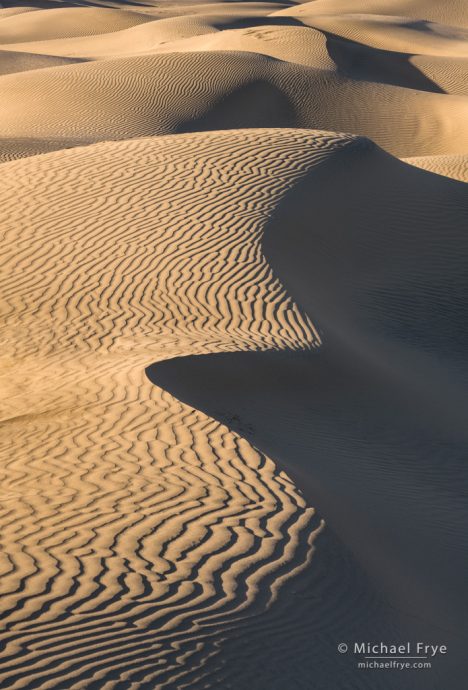
Forms and textures, Mesquite Flat Dunes, Death Valley. 1/20th sec. at f/16, ISO 100, 106mm (focus stacked).
I used my 70-200 zoom almost exclusively in the dunes, since it’s such a great tool for emphasizing patterns. In most cases the distance between foreground and background was great, making it challenging to get everything in focus with such long focal lengths. I kept the aperture small (usually at f/16) to increase the depth of field, and focused carefully, but sometimes that wasn’t enough to get everything in focus, so I often used focus-stacking.
And although I checked every direction, I was primarily looking toward the sun, or at right angles to it, as backlight and sidelight almost always work best for bringing out the forms and textures of the sand.
You’ll find a few more dune photographs from our recent trip below. If you’ve never photographed sand dunes I highly recommend it. The Mesquite Flat Dunes in Death Valley are quite popular, but there are many other dune fields in the California deserts, plus the Oceano Dunes near Pismo Beach. And of course there’s Great Sand Dunes National Park in Colorado, Coral Pink Dunes in Utah, and White Sands in New Mexico. Photographing dunes is great fun, and I can’t wait to do it again.
— Michael Frye
Related Posts: Finding Rhythm; Nice Curves
Michael Frye is a professional photographer specializing in landscapes and nature. He is the author or principal photographer of The Photographer’s Guide to Yosemite, Yosemite Meditations, Yosemite Meditations for Women, Yosemite Meditations for Adventurers, and Digital Landscape Photography: In the Footsteps of Ansel Adams and the Great Masters. He has also written three eBooks: Light & Land: Landscapes in the Digital Darkroom, Exposure for Outdoor Photography, and Landscapes in Lightroom: The Essential Step-by-Step Guide. Michael has written numerous magazine articles on the art and technique of photography, and his images have been published in over thirty countries around the world. Michael has lived either in or near Yosemite National Park since 1983, currently residing just outside the park in Mariposa, California.

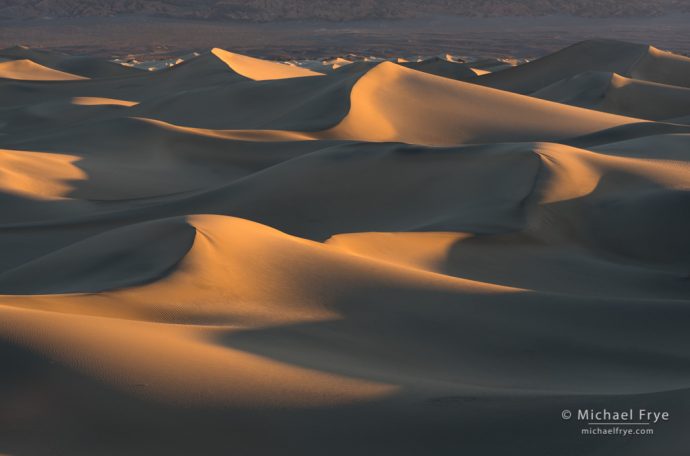
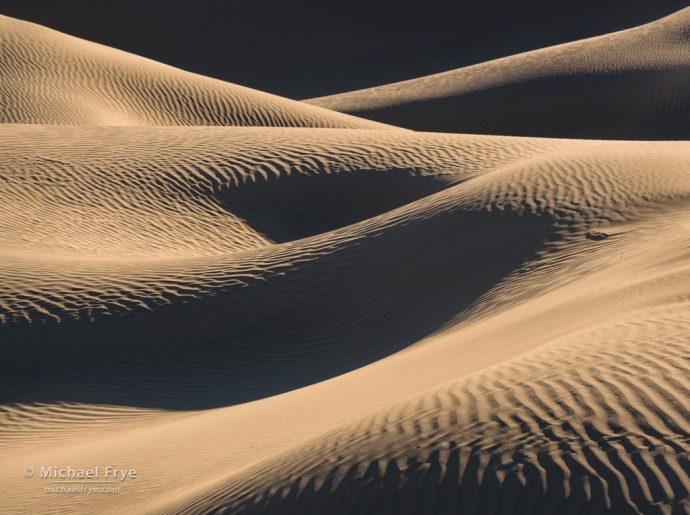
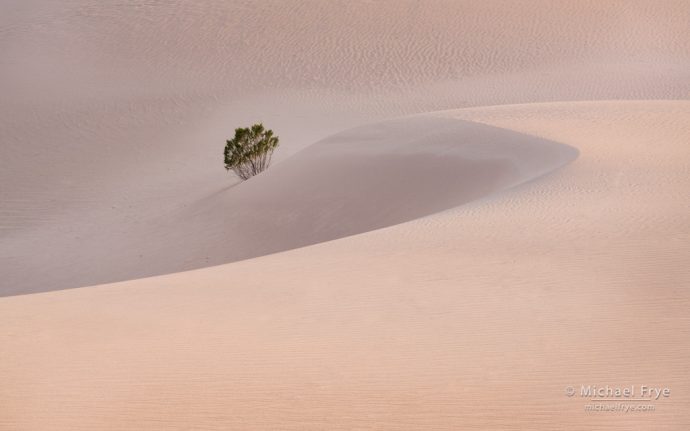
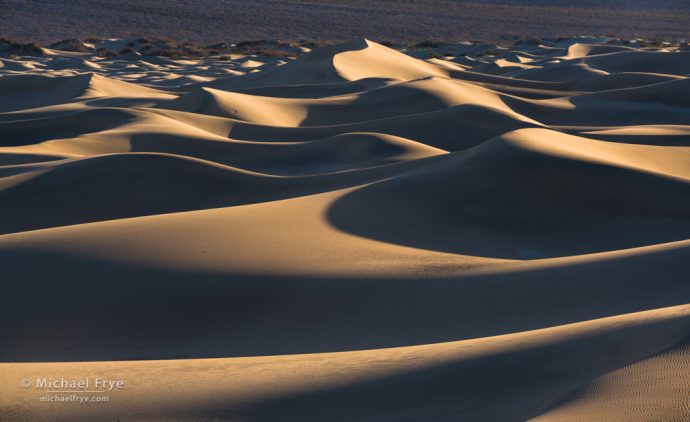
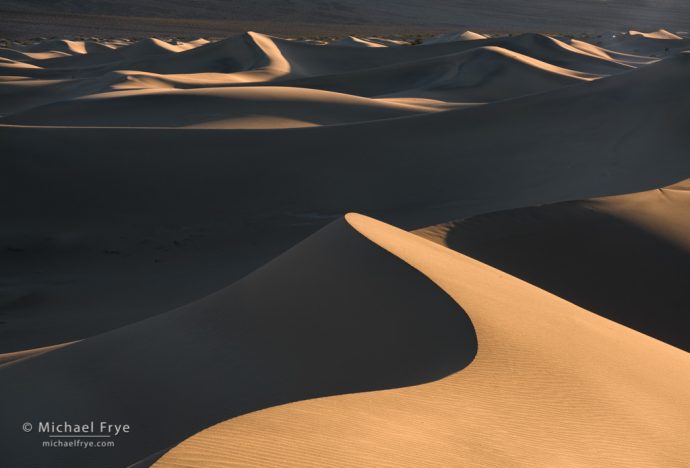








What is focus stacked, Michael?
Good question Deb. Here’s some more info:
https://www.michaelfrye.com/2016/04/11/focus-stacking-season/
What do you do if there’s a breeze?
I find those dunes absolutely mesmerizing, Michael. I love the play of light and shadow, and the curves and ripples.
Me too! 🙂
Beautiful Michael. But, how do you not freeze, camping in Death Valley this time of year? And isn’t diffraction a problem at F16?
Thanks John. It’s Death Valley, after all, and holds the record for the hottest temperature ever recorded on earth, so even in winter it rarely gets that cold. We had lows in the 40s. Next week the highs will be in the low 90s. As for diffraction, no, it isn’t a problem for me with that lens (a Canon 70-200 f/4L). It’s quite sharp at f/16. I find that better lenses often hold up quite well at f/16, though there’s a noticeable falloff in sharpness at f/22.
Gorgeous images, Michael, thanks so much. Such beautiful textures; the light and shadow is just amazing. I imagine these would also make great b/w images. I’ve heard that with all the rain California has had that the wildflowers in the desert are really stunning this year.
Though I’ve been to Death Valley several times, I’ve never had the opportunity to photography the dunes there. Rather embarrassing since I’ve lived in California and northern Nevada for most of my life. Maybe someday.
Thanks Bob! Everyone is predicting a great flower year in southern California, but so far that has yet to materialize. It’s early though.
“WOW” Michael – Yet Again Incredible Photography, Death Valley Is A Wonderful Place For Photography.
These Images Are Outstanding.
Thanks John!
I’m surprised. You are a very creative and imaginative photographer and you came away with what ever other photographer comes away with – samo, samo. The challenges are in front of you M.; because you see the same places year after year. Good luck – be more creative – more self referral oriented. You’ve done better and I seen you at “better” even “great”. Have fun.
So Joseph. Let’s see your work. What’s your website so we can all see your masterpieces that look like no other photographer.
Michael: Nice images as always. Keep up the good work.
My point: Create, don’t mimic. We don’t want another Ansel Adams. We want to experience “you” – the “creative you”.
Thanks Dave!
Joseph, I wasn’t trying to create the most amazing and original dune photo ever. As I wrote, I was just having fun looking for patterns, forms, and textures. Does every photographic venture have to stretch the boundaries and go beyond what’s been done before, or can we sometimes just go out and have fun? On previous trips to Death Valley I’ve made some dune photos that are a bit different (links below), but if I felt that I had to do something super-creative and original every time I picked up my camera I would have become worn down by that impossible burden long ago and given up photography.
https://www.michaelfrye.com/2015/05/03/sand-dune-milky-way/
https://www.michaelfrye.com/2014/09/07/heat-night/
And it shows; i.e., lack of “super-creative”. (you term). Being creative doesn’t mean “work”. Look at people like, John Paul Caponigro, Jerry Seifeld, Chris Orwig, Simon Cowell, Taylor Swift; all having fun while being greatly creative. I say to you, landscape photography is dead – prove to us out here, it isn’t. Have fun. J
You don’t know what you’re talking about.
Beautiful photos!
To add to your list of dunes in the last paragraph: We have big sand dunes in Oregon, too! On the coast at Oregon Dunes National Recreation Area and the Christmas Valley sand dunes in eastern Oregon.
Thanks Greg – I forgot about the Oregon Dunes, and I never knew about the Christmas Valley dunes. I’m sure there are many other dunes out there I’m not familiar with too, and most of them probably provide great opportunities for photography.
Thanks for this post Michael, it opened my eyes to some different ways to approach dunes.
I’ve been to Oregon Dunes a couple of times and had a blast there. This makes me want a rematch.
I really enjoy your approach of encouraging seeing patterns and trying things. Looking for different types of patterns and playing with them opens my eyes to all sorts of different layers around me. And I find doing that helps me see the world in different ways even when I’m not shooting.
Actually, it always feels like I am out shooting even if I’m not ;-).
Thanks as always,
Doug
Thanks for your comments Doug. Glad you’re out there looking for patterns – that’s such a big key to composition.
Thanks Michael for this article.
You’ve described exactly my feeling every time I have chance to visit the sand dunes.
You just remind me something I didn’t think about when photograph these sand dunes …… stacking. Will have to try it next time.
Once again, thank for this helpful hint.
Anna P
You’re welcome Anna. Glad you enjoy the sand dunes too!
“Sand & Creosote Bush…” In a word, sublime.
Glad you like that one SallyO – thanks!
Beautiful photographs Michael! Thank you for the pictures and the narrative.
Steve Parisi
Thanks Steve!
I really like your sand dunes. They are so soft and yet crystal clear all at the same time. And the many many shads of light and dark, I imagine the surface feels like soft foam, Just Beautiful,
Thanks very much Roger!